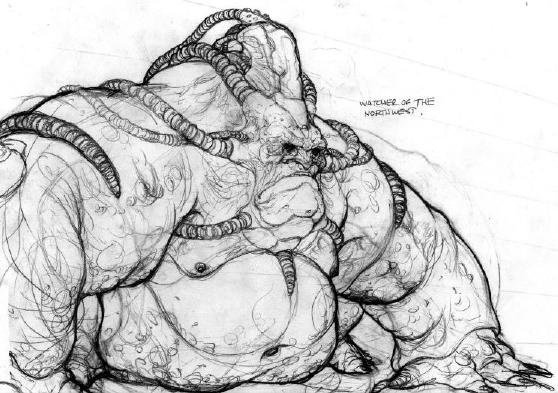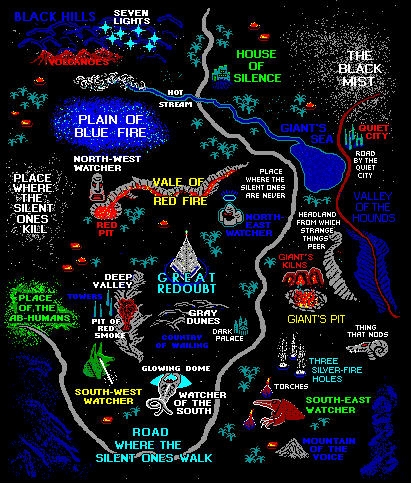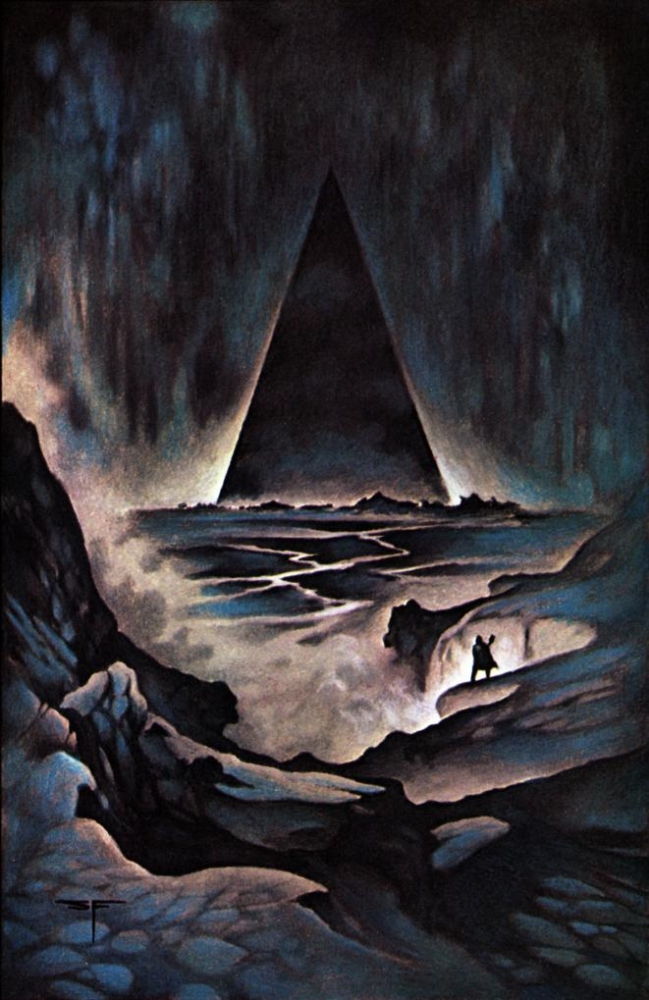In the Grim Darkness of the Far Future, There Is Only Cringe (The Night Land Review)
I don't know if any author has fumbled a great premise as hard as this.
The Good
Untold aeons in the future, the sun & stars have guttered out and the last remnants of humanity live in a vast pyramidal arcology called the "Last Redoubt". Everything else is The Night Land, an eerie, barren landscape of smoldering pits, mysterious lights, and ruined architecture. A menagerie of sinister monsters lurk in the shadows: giants, "night-hounds", "ab-humans", and titanic Eldritch horrors known as "watchers" that inch closer and closer to the Redoubt over hundreds of thousands of years (surely an inspiration to Lovecraft). "Doors in the night" emit a buzzing that sounds like it's right in your ear, a "spinning" noise stalks the narrator over a dry seabed, and the "House of Silence", exudes cold light from within, luring passers-by to a fate apparently worse than death.
Wonderful toponyms too: "The Road where the silent ones walk", "The Place from Whence Comes the Great Laughter", "The Place where the Silent Ones Are Never", "Headlands from which Strange Things Peer".
A young man in the Redoubt starts receiving psychic messages from a girl in a separate, distant Redoubt that's on the brink of being overrun by monsters, so he dons armor, grabs his diskos (sort of a lightsaber buzzsaw), and ventures out to rescue her, intrepidly braving the dangers of the Night Land.
It's original, vivid cosmic horror, awesome and truly bleak. (I appreciate how, unlike later authors lumped into the "Dying Earth" subgenre, Hodgson sets his story after the sun has gone out). It's the sort of book I truly want to love in spite of its flaws.
But goddamn it's like Hodgson was actively trying to make it unreadable.
The Bad
First, there's the language, approximating 17th century English. A representative passage:
And I saw now that the Night Land that I did wot of, was hid from me by the slope. And I turned and looked down the slope; and surely all before me was utter wildness of a dark desolation; for it did seem to go nowhither but into an everlasting night. And there was no fire down there, neither light of any kind; but only Darkness and, as I did feel, Eternity. And downward into that Blackness did the great slope seem to go for ever.
Faux-archaic prose is by no means a dealbreaker -- I adore the works of E.R. Eddison & Clark Ashton Smith, and at times The Night Land has a magnificent gravitas:
And they made dim the lights in the Great Causeway, that there should no glare go forth into the Land, when the Gate was opened; and behold, they opened not the lesser gate within the greater, for me; but did honour my journey, in that they swung wide the Great Gate itself, through which a monstrous army might pass. And there was an utter silence all about the Gate; and in the hushed light the two thousand that made the Full Watch, held up each the Diskos, silently, to make salute; and humbly, I held up the Diskos reversed, and went forward into the Dark.
The language also creates a feeling of temporal distance (oddly, the fanciful future technologies feel less dated than the overconfident Edwardian technobabble in Bourroughs' Mars books). But whereas authors like Eddison & Smith used archaism to expand their capacity for expression in interesting ways, after ~50 pages it becomes clear that Hodgson is drawing on a very limited set of words and phrases, the overall effect being stuffy & tedious.
The narrative itself is equally repetitive. Anything remotely interesting is buried in page after page of journal-like accounting of every time the narrator eats & sleeps. (I have to assume that the nutrient pills he subsists on do not precipitate bowel movements; otherwise the book would run to at least 600 pages). Every event, notable or not, gets paraphrased two or three times, plus a little recap paragraph where he adds a line like "And so you shall perceive this wondrous strange thing which I have set down". Best of all, once he reaches his damsel in distress, the return journey hits exactly the same beats as the trip out, just in reverse order.
And then there's the damsel in distress, Naani. It's clear that Hodgson was earnestly trying to evoke a "fair maiden" archetype (with the narrator as chivalrous knight errant), but the result is simultaneously ridiculous & very creepy. Naani is portrayed as an airheaded, capricious waif whose preferred activities are cuddling, smooching, preparing little meals, and frolicking with wanton disregard for nearby danger. (Hodgson reads as the type of guy who would call his girlfriend "kitten" in public).
And when I was full armed, she took my hand, and set mine arm about her waist, and she leaned her head against my breast, and put up her lips to be kist, as that she did be a child maiden; yet when I kist her, she did be a woman, and to kiss me very dear and loving, and to look at me then from under her eye-lids; and sudden to make a dainty growling, and to pretend that she did be a fierce thing that should be like to eat me; and I to be utter feared, as you shall think, and to be scarce able that I kiss Mine Own Pretty Fierce One, because that I did laugh so hearty, and to be so taken with a surprise that the Maid did show this new playfulness; and in the same moment to be stirred and waked anew that she did be so lovely and graceful in mine arms, and to make her naughty growling so pretty that I did be eager that she make it again; but she to do this playing only as her mood did stir her.
There are dozens of variations on this paragraph throughout the second half of the book, and there is no direct dialogue, so the entirety of her characterization is conveyed this way.
The Very Ugly
What would be merely annoying becomes genuinely revolting after lovestruck Naani plays one too many idiotic pranks while traversing the most dangerous landscape imaginable. To remedy her wanton 'naughtiness', the narrator whips her with a belt and then delivers an extended sermon on the properness of establishing mastery over one's True Love. With this, my residual desire for a sympathetic reading evaporated.
Unlike later 'Dying Earth' novelists, I don't think Hodgson meant to frame this as some kind of far-future moral degeneration -- it seems very clear that for him, the Narrator's relationship to Naani is holy, celestial love, a beacon of light in an otherwise hopeless universe, and representative of the proper relation between men & women. Nor could it reasonably be described as 'kinky' or transgressive unless there's some kind of 5d-chess way to read liberatory eroticism into pages of po-faced sermonizing.
In a bizarre inversion of his apparent intent, the bleakest part of the book is not the blasted monster-infested world or eternal night but the fact that its ideal of 'True Love' is shallow, juvenile, and tainted with sadism.
I read this in an effort to read everything in the 'Dying Earth' speculative fiction sub-genre, and unless you're a similar completionist or diehard weird fiction enthusiast, I would not recommend it. I really hoped I'd see something beyond the standard writing: bad, worldbuilding: good take, but I'm baffled at what Hodgson was trying to achieve -- it feels like there's an obvious 150-page sf novella hiding in this bloated 500-page mess. Maybe it's an antimemetic shell that safeguards some esoteric profundity from philistines like me, but I doubt it.
With that said, the fact that people are still reading it at all speaks to the incredible pull of its imagery. I've sprinkled fanart throughout this review because it genuinely kicks ass.
There's ample ttrpg potential here, and I would be surprised that it hasn't appeared in more people's Appendix Ns were it not for the everything written above. Still, it's a hexcrawl novel par excellence, with detailed geography, varied terrain, landmarks, random encounters etc. It's also in the public domain, so it's (perhaps) easier to excise the objectionable aspects without worrying about platforming a bigot.
The plot could be remixed into a neat tournament module or capsule game, with the PCs as a crack team sent to rescue as many people from the Lesser Redoubt as possible, with the number of survivors at the end being one's 'score'. (Like the hexcrawl equivalent of a negadungeon).
If any of this is of interest, you can experience most of the interesting worldbuilding & skip the bulk of the annoying & objectionable stuff by reading chapters 2-7, the slug fight in chapter 12, and maybe the concluding action in chapter 15. There's also a rewritten version that's supposed to be pretty good, and various abridgments.
But honestly, I think the best thing that could happen with this book would be for someone to adapt it into a Soulslike videogame, a medium where the minimal characterization is less off-putting, the repetition is a feature, and which might do justice to the awesome crags, eerie lights, and Titanic monsters of Hodgson's imagination.



